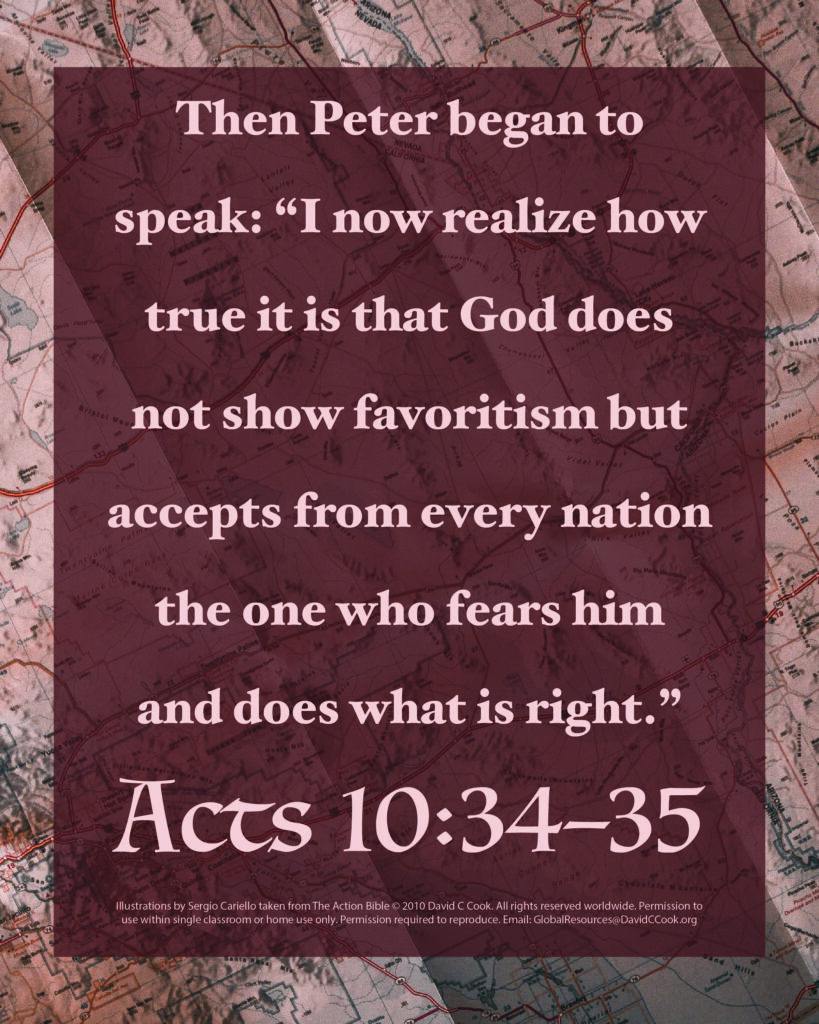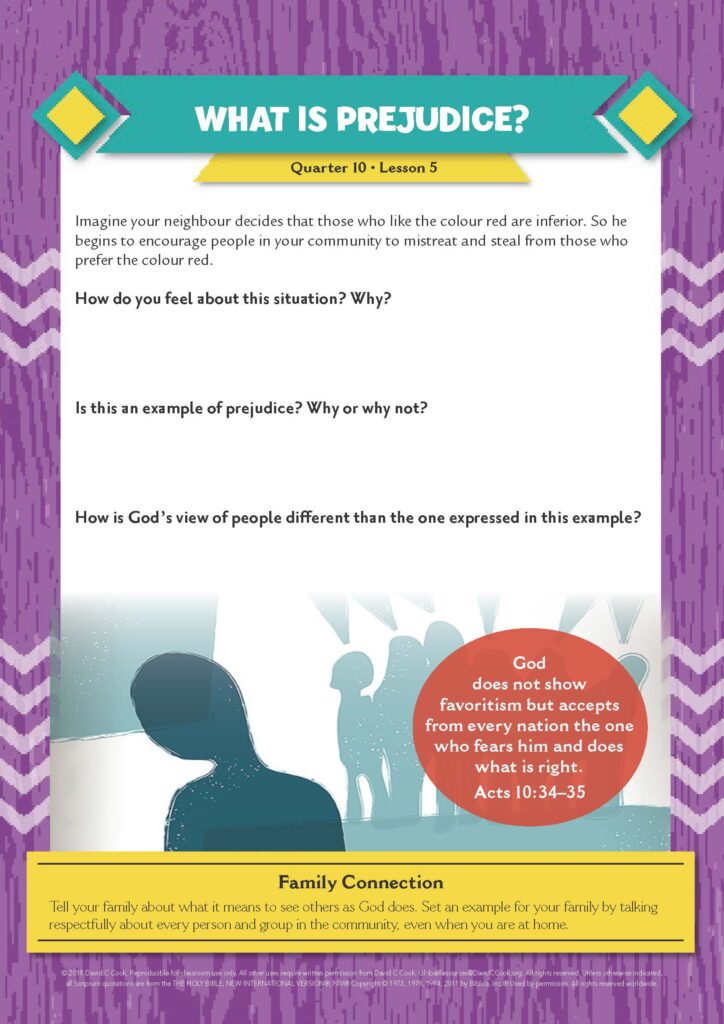During the lesson, the information for you to know is written in regular type, and what we suggest speaking or reading aloud to children is in bold. All resources for this lesson, including the Teacher Guide, Student Page, Family Connection Card, and other resources can be downloaded in a ZIP file by clicking on the following link:
In some lessons you will find "resource articles." These are articles written by experts from around the world to help equip you for your work with children and adolescents. Share them with parents or guardians if you consider it appropriate.
My brothers and sisters, believers in our glorious Lord Jesus Christ must not show favoritism.
James 2:1
You play an important part in God’s story. Every day—at the market, at your job, in your home—you are bringing the light of God’s love into the world. Every time you walk into your classroom, a group of teens looks to you to bring truth and light. Your light is shining before others, and your good works are bringing God’s love to the world and glory to His name!
In what areas of your life are you able to shine God’s light easily and well? In what areas do you struggle? Ask God to help you to be a bit more loving, a bit more forgiving, a bit more truthful, a bit more compassionate, a bit more like Jesus. And as you faithfully follow God’s call to be a light of the world, know that you are not alone. Jesus, who brought the light of truth and grace into your life, is with you always. Ask Him to help you to bring glory to His great name.
Encourage students to retell all of God’s story to their family members. The teens can then find ways to share God’s love in their homes and communities.
Teacher Tip: If possible, email or text the Family Connection Card to the families of your students.
Welcome the teens warmly as they arrive. Ask them to tell you their favourite part of God’s story. Let them know that they will learn the next exciting part of God’s story in this lesson.
What are the parts of God’s story that we have learned so far?
Call on 3 different teens to briefly share the 3 parts of the story from the first 3 lessons. Hold up the posters from these lessons to help them to remember the details. Invite the other students to add the details the students missed. Congratulate the students for remembering the stories well.
Review the motions from the first 3 lessons. If possible, allow a few teens to lead the group. Have all of the students do them a few times to be sure they know all the motions.
We have learned that God created the world and everything in it—including you and me. We have learned that sin and death entered the world and separated us from God. We have also learned that Jesus died, rose again, and ascended to heaven to create a bridge so that we are no longer separated from God. He offers us a gift—the gift of forgiveness, which allows us to live forever with Him.
But that is not the end of God’s story! What do you think happens next?
Allow 2–3 students to share their thoughts.
The Bible tells us that God created the world and that someday He will return to earth to restore it to the way He intended for it to be. Until then, He continues to walk closely with those who follow Him. He also seeks to win the hearts of those who do not yet know and love Him. His story continues in our lives!
Give the students a few minutes to create motions for this lesson: Our Part in the Story. Repeat the motions a few times together as a group to help them to remember the motions.
We all have a place in God’s story. He will use us to accomplish His will and to bring glory to Himself. Even though we sometimes sin and make poor choices, we are invited to be part of His amazing work! Let’s learn more about how we can do that.
God has been working in the world and the lives of the people He created from the beginning. We can see God’s love, power, and glory in His creation and in the people around us. We are all part of God’s story!
What do you think it means to be part of God’s story?
Allow 2–3 students to share their ideas.
Everything and everyone God created can bring glory to Him. God continues to work toward accomplishing His plan to bring restoration—to bring all things to perfection and even to make all things new in the age to come.
We are human, and we cannot be perfect and holy by our own strength or efforts. But, with the help of the Holy Spirit, we can learn and grow to become more like Jesus. When we believe in Him and obey Him, we point others toward Him. Only God can transform the hearts and lives of others, but we can help others to know Him.
In order to recognize our place in God’s story, we need to be attentive to Him and to what He is calling us to do. Here are some things you can do to grow closer to God and learn the part you have in His story.
1. Pray. When we talk with God and learn to listen and respond to Him, we grow closer to Him. God cares deeply for us. When we call on His name, He hears us. When we spend time listening to Him, we can find out what He wants for our lives. Listen to what the Bible tells us about how God listens to our prayers.
This is the confidence we have in approaching God: that if we ask anything according to his will, he hears us.
1 John 5:14
2. Read the Bible. God’s Word tells us His story. It also teaches us how we can walk closely with Him. Listen to what these verses say about Scripture itself, the Bible.
All Scripture is God-breathed and is useful for teaching, rebuking, correcting and training in righteousness, so that the servant of God may be thoroughly equipped for every good work.
2 Timothy 3:16–17
3. Obey God—even when it is hard. When we make the decision to follow Jesus, we will spend the rest of our lives learning to obey and be more like Him. That means listening to and learning from God and the people He puts into our lives to help us. It means obeying His will, even when it is difficult. It means trusting in Him even when we face challenges. The Holy Spirit, who lives in all believers, gives us strength and courage when we struggle to trust and obey God. When we follow God in the good times and the difficult ones, we grow in faith and we bring glory to God.
If you are using the Memory Verse Poster, show it to the students.
And this is love: that we walk in obedience to his commands.As you have heard from the beginning, his command is that you walk in love.
2 John 1:6

4. Look for opportunities to share God’s love and forgiveness. When we accept God’s gift of grace, we also accept the responsibility of sharing it with others. Sometimes that means sharing His story and leading others to Him. Other times, it means treating others with love, compassion, and kindness or showing forgiveness when it is not earned or deserved. When we treat others as God intends, we are contributing to His work.
You are the light of the world. A town built on a hill cannot be hidden. Neither do people light a lamp and put it under a bowl. Instead they put it on its stand, and it gives light to everyone in the house. In the same way, let your light shine before others, that they may see your good deeds and glorify your Father in heaven.
Matthew 5:14–16
When we pray, read the Bible, follow Jesus even when it is difficult, and look for opportunities to share God’s love and forgiveness, we learn to be more like Jesus. We grow in our faith, and we bring glory to God.
Now we have learned 4 parts of God’s story. Let’s see if we can remember the whole story together!
Lead the students in doing the motions for each part of the story: God Is Our Loving Creator, Sin Separates Us from God, Jesus Brings Us Back to God, and Our Part in the Story. Put the posters from all 4 lessons somewhere the students can see them. Have them find partners and retell all 4 parts of the story with their partners.
When we first started learning about God’s story, we acted out scenes from our own lives. We learned that our stories are part of a much greater story—God’s story! His story is not finished, and neither is yours! Regardless of what you have done or what has happened to you, God has a plan for you! He has a place for you in His story! If you are not a Christian, God still wants you to be a part of His story! He can use you to help others.
Before He ascended to heaven, Jesus gave His followers a specific way to be part of God’s story. This is what He said:
Then the eleven disciples went to Galilee, to the mountain where Jesus had told them to go. When they saw him, they worshiped him; but some doubted. Then Jesus came to them and said, “All authority in heaven and on earth has been given to me. Therefore go and make disciples of all nations, baptizing them in the name of the Father and of the Son and of the Holy Spirit, and teaching them to obey everything I have commanded you. And surely I am with you always, to the very end of the age.”
Matthew 28:16–20
What did Jesus tell His followers to do?
He told them to go and make disciples and to baptise and teach them.
What promise did He make?
He would be with them always.
Jesus told His followers to tell others about God’s story. When we tell this story, we are sharing about God’s great love for us. We are telling them about God’s amazing grace, which brings forgiveness that we have not earned and do not deserve. We are telling them about the sacrifice Jesus made to bring each one of us back to God, regardless of what we have done or what has been done to us. And we are telling them how each one of us can be part of His story by following and obeying Him!
Optional: If you are using the Student Pages, have your students complete the activity.

Have the students share their answers to the following questions with their partners.
What is something you have learned about God from His story that you want to share with someone else?
What are some practical ways you can share God’s story with others?
Give the teens 2–3 minutes to discuss their answers with their partners. Then allow 2–3 students to share their ideas with the whole group.
Close with a blessing based on Matthew 28:16–20:
Blessing: May you find confidence instead of doubt, knowing that the Creator of heaven and earth stands beside you. May you share His story and His love with others every day!
Lead the teens in singing this quarter’s song, if possible.
Life on Life ©2020 David C Cook. Reproducible for home or classroom use only. All other uses require written permission from David C Cook [email protected]. All rights reserved.